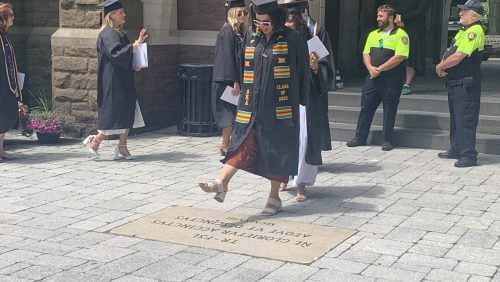23 Things You May Not Know About Trinity
By Kathy Andrews

Article by Kathy Andrews, former communications staffer at Trinity College and at The Hartford Courant. View the full story, originally published in the Hartford Courant, April 28, 2023.

May 2023 marks 200 years since the 1823 founding in Hartford of Trinity College. In recognition of this milestone, here are 23 things you may not know about this liberal arts institution, whose theme for its year-long bicentennial celebration is “Committed to the future since 1823.”
Second
Trinity is the second-oldest higher education institution in Connecticut; Yale University is the oldest.
Renamed
Originally founded in 1823 as Washington College, the school renamed itself Trinity College in 1845, to avoid confusion with other institutions named after George Washington.
Nonsectarian
While Trinity’s renaming underscored its religious heritage—its founding president was Episcopalian Bishop Thomas Church Brownell—Trinity has always welcomed students of all religious backgrounds.
Relocated
Trinity’s original campus was where Connecticut’s State Capitol now stands. The College moved in 1878 to its 100-acre campus bordered by Summit Street, New Britain Avenue, Broad Street, and Allen Place—situated between Hartford’s Frog Hollow and Barry Square neighborhoods.
Blue and Gold
When Trinity relocated, students called for new colors for the “new Trinity” to replace the green and white. They voted for dark blue and gold because they “go well together.”
The Bantam
A Pennsylvania federal judge and 1875 Trinity alumnus, Joseph Buffington, first introduced Trinity’s bantam mascot in a speech at an 1899 Princeton Alumni Association dinner. Referring to Harvard, Yale, and Princeton as the big shots of the “collegiate barnyard,” he described Trinity as a proud, little bantam, “not a whit abashed at your hugeness, [and] satisfied with himself and his own particular coop.”
Long Walk
The three oldest buildings on campus—Seabury Hall, Northam Towers, and Jarvis Hall—make up Trinity’s Long Walk, considered the finest example in America of High Victorian Collegiate Gothic architecture.
Luther-Roosevelt Stone
In the middle of the Long Walk, a rectangular stone set into the sidewalk commemorates a 1918 visit by former U.S. President Theodore Roosevelt, who was invited by then-Trinity President Flavel S. Luther. Students avoid walking on the stone before commencement, fearing that to do so would prevent their graduating. Stepping—or dancing—on the stone is a favorite commencement tradition.